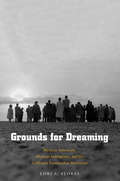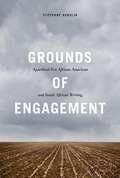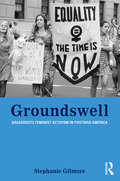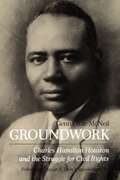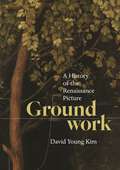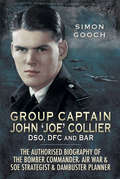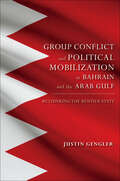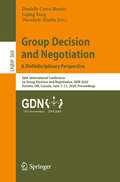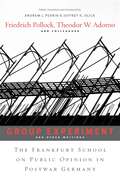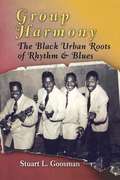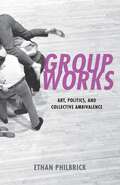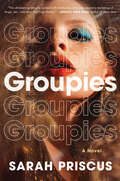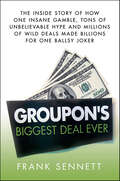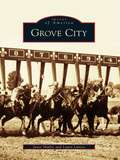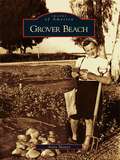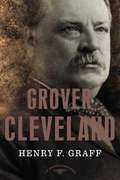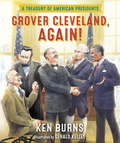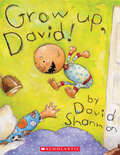- Table View
- List View
Grounds for Dreaming
by Lori A. FloresAn incisive study of labor, migration, race, gender, citizenship, and class, Lori Flores’s first book offers crucial insights for today’s ever-growing U.S. Latino demographic, the farmworker rights movement, and future immigration policy.
Grounds of Engagement: Apartheid-Era African-American and South African Writing
by Stephane RobolinPart literary history, part cultural study, Grounds of Engagement examines the relationships and exchanges between black South African and African American writers who sought to create common ground throughout the antiapartheid era. Stéphane Robolin argues that the authors' geographic imaginations crucially defined their individual interactions and, ultimately, the literary traditions on both sides of the Atlantic. Subject to the tyranny of segregation, authors such as Richard Wright, Bessie Head, Langston Hughes, Gwendolyn Brooks, Keorapetse Kgositsile, Michelle Cliff, and Richard Rive charted their racialized landscapes and invented freer alternative geographies. They crafted rich representations of place to challenge the stark social and spatial arrangements that framed their lives. Those representations, Robolin contends, also articulated their desires for black transnational belonging and political solidarity. The first book to examine U.S. and South African literary exchanges in spatial terms, Grounds of Engagement identifies key moments in the understudied history of black cross-cultural exchange and exposes how geography serves as an indispensable means of shaping and reshaping modern racial meaning.
Groundswell: Grassroots Feminist Activism in Postwar America
by Stephanie GilmoreGroundswell: Grassroots Feminist Activism in Postwar America offers an essential perspective on the post-1960 movement for women’s equality and liberation. Tracing the histories of feminist activism, through the National Organization of Women (NOW) chapters in three different locations: Memphis, Tennessee, Columbus, Ohio, and San Francisco, California, Gilmore explores how feminist identity, strategies, and goals were shaped by geographic location. Departing from the usual conversation about the national icons and events of second wave feminism, this book concentrates on local histories, and asks the questions that must be answered on the micro level: Who joined? Who did not? What did they do? Why did they do it? Together with its analysis of feminist political history, these individual case studies from the Midwest, South, and West coast shed light on the national women’s movement in which they played a part. In its coverage of women’s activism outside the traditional East Coast centers of New York and Boston, Groundswell provides a more diverse history of feminism, showing how social and political change was made from the ground up.
Groundwork
by Genna Rae Mcneil A. Leon Higginbotham Jr."A classic. . . . [It] will make an extraordinary contribution to the improvement of race relations and the understanding of race and the American legal process."--Judge A. Leon Higginbotham, Jr., from the ForewordCharles Hamilton Houston (1895-1950) left an indelible mark on American law and society. A brilliant lawyer and educator, he laid much of the legal foundation for the landmark civil rights decisions of the 1950s and 1960s. Many of the lawyers who won the greatest advances for civil rights in the courts, Justice Thurgood Marshall among them, were trained by Houston in his capacity as dean of the Howard University Law School. Politically Houston realized that blacks needed to develop their racial identity and also to recognize the class dimension inherent in their struggle for full civil rights as Americans.Genna Rae McNeil is thorough and passionate in her treatment of Houston, evoking a rich family tradition as well as the courage, genius, and tenacity of a man largely responsible for the acts of "simple justice" that changed the course of American life.
Groundwork: A History of the Renaissance Picture
by David Young KimAn illuminating look at a fundamental yet understudied aspect of Italian Renaissance paintingThe Italian Renaissance picture is renowned for its depiction of the human figure, from the dramatic foreshortening of the body to create depth to the subtle blending of tones and colors to achieve greater naturalism. Yet these techniques rely on a powerful compositional element that often goes overlooked. Groundwork provides the first in-depth examination of the complex relationship between figure and ground in Renaissance painting.“Ground” can refer to the preparation of a work’s surface, the fictive floor or plane, or the background on which figuration occurs. In laying the material foundation, artists perform groundwork, opening the ground as a zone that can precede, penetrate, or fracture the figure. David Young Kim looks at the work of Gentile da Fabriano, Giovanni Bellini, Giovanni Battista Moroni, and Caravaggio, reconstructing each painter’s methods to demonstrate the intricacies involved in laying ground layers whose translucency and polychromy permeate the surface. He charts significant transitions from gold ground painting in the Trecento to the darkened grounds in Baroque tenebrism, and offers close readings of period texts to shed new light on the significance of ground forms such as rock face, wall, and cave.This beautifully illustrated book reconceives the Renaissance picture, revealing the passion and mystery of groundwork and discovering figuration beyond the human figure.
Group Captain John 'Joe' Collier DSO, DFC and Bar: The Authorised Biography of the Bomber Commander, Air War & SOE Strategist & Dambuster Planner
by Simon GoochJohn Collier's war began on day one, flying Hampdens in 83 Squadron with his friend Guy Gibson, in a hunt for the battleship Admiral Scheer. By the summer of 1940 he was bombing the Dortmund-Ems Canal at low-level, then Bordeaux and the Scharnhorst at Brest, which led to his DFC and Bar. Given command of 420 (RCAF) Squadron at 25, Collier was hand-picked to direct 97 Squadron, whose Lancasters made a spectacular debut with the 1942 Augsburg Raid. In Gibson's opinion Joe Collier's 97 was the best unit in Bomber Command. After 63 missions Collier was awarded the DSO and was selected to join the Directorate of Bomber Operations (B Ops 1) at the heart of the air war: co-ordinating with the USAAF, issuing directives to Bomber Command, and arguing for precision attacks on vital enemy industries and weaponry. In B Ops 1 John Collier was closely involved in planning the Dambuster Raid with Barnes Wallis, drafted the attack on Peenemunde's V-weapons research station, and managed to delay the buzz-bomb and rocket assault on London. As target selector for the specialist 617 Squadron, he and Leonard Cheshire VC made imaginative use of Wallis's Tallboy earthquake bomb. 617 were also linked to Collier's role with SOE's Blackmail Committee that gave French industrialists a stark choice: sabotage your own plant or be bombed flat. By the time he moved to India in 1945 as Deputy Director of Combined Ops, John Collier had been involved in most of the major initiatives of the bomber war. His unpublished memoir of B Ops 1 and his logbooks and letters home give direct authority to this the first biography of this remarkable flyer, one of the most significant young RAF officers of the war.
Group Conflict and Political Mobilization in Bahrain and the Arab Gulf: Rethinking the Rentier State
by Justin Gengler&“Invaluable to anyone wanting a fuller understanding of the economic, political, and religious tensions within Bahrain.&” —The Sociological Imagination The oil-producing states of the Arab Gulf are said to sink or swim on their capacity for political appeasement through economic redistribution. Yet, during the popular uprisings of the Arab Spring, in Bahrain and all across the Arab Gulf, ordinary citizens showed an unexpected enthusiasm for political protest directed against governments widely assumed to have co-opted their support with oil revenues. Justin Gengler draws on the first-ever mass political survey in Bahrain to demonstrate that neither is the state willing to offer all citizens the same bargain, nor are all citizens willing to accept it. Instead, shared social and religious identities offer a viable basis for mass political coordination. Challenging the prevailing rentier interpretation of political life in the Gulf states, Gengler offers new empirical evidence and a new conceptual framework for understanding the attitudes of ordinary citizens.
Group Decision and Negotiation: 20th International Conference on Group Decision and Negotiation, GDN 2020, Toronto, ON, Canada, June 7–11, 2020, Proceedings (Lecture Notes in Business Information Processing #388)
by Liping Fang Danielle Costa Morais Masahide HoritaThis book constitutes the refereed proceedings of the 20th International Conference on Group Decision and Negotiation, GDN 2020, which was planned to be held in Toronto, ON, Canada, during June 7–11, 2020. The conference was cancelled due to the Coronavirus pandemic. Nevertheless, it was decided to publish the proceedings, because the review process had already been completed at the time the cancellation was decided. The field of Group Decision and Negotiation focuses on decision processes with at least two participants and a common goal but conflicting individual goals. Research areas of Group Decision and Negotiation include electronic negotiations, experiments, the role of emotions in group decision and negotiations, preference elicitation and decision support for group decisions and negotiations, and conflict resolution principles. The 14 full papers presented in this volume were carefully reviewed and selected from 75 submissions. They were organized in topical sections named: Conflict Resolution, Preference Modeling for Group Decision and Negotiation, Intelligent Group Decision Making and Consensus Process, Collaborative Decision Making Processes.
Group Experiment and Other Writings: The Frankfurt School on Public Opinion in Postwar Germany
by Theodor W. Adorno Jeffrey K. Olick Andrew J. Perrin Friedrich PollockTheodor W. Adorno and his Frankfurt School colleagues published their findings on their group discussion experiments that delved deeper into the process of opinion formation.Andrew J. Perrin and Jeffrey K. Olick make a case that these experiments are an important missing link in the ontology and methodology of current social-science survey research.
Group Harmony
by Stuart L. GoosmanIn 1948, the Orioles, a Baltimore-based vocal group, recorded "It's Too Soon to Know." Combining the sound of Tin Pan Alley with gospel and blues sensibilities, the Orioles saw their first hit reach #13 on the pop charts, thus introducing the nation to vocal rhythm & blues and paving the way for the most successful groups of the 1950s.In the first scholarly treatment of this influential musical genre, Stuart Goosman chronicles the Orioles' story and that of myriad other black vocal groups in the postwar period. A few, like the Orioles, Cardinals, and Swallows from Baltimore and the Clovers from Washington, D.C., established the popularity of vocal rhythm & blues nationally. Dozens of other well-known groups (and hundreds of unknown ones) across the country cut records and performed until about 1960. Record companies initially marketed this music as rhythm & blues; today, group harmony continues to resonate for some as "doo-wop."Focusing in particular on Baltimore and Washington and drawing significantly from oral histories, Group Harmony details the emergence of vocal rhythm & blues groups from black urban neighborhoods. Group harmony was a source of empowerment for young singers, for it provided them with a means of expression and some aspect of control over their lives where there were limited alternatives. Through group harmony, young black males celebrated and musically confounded, when they could not overcome, complex issues of race, separatism, and assimilation during the postwar period.Group harmony also became a significant resource for the popular music industry. Goosman interviews dozens of performers, deejays, and industry professionals to examine the entrepreneurial promise of midcentury popular music and chronicle the convergence of music, place, and business, including the business of records, radio, promotion, and song writing.Featured in the book's account of the black urban roots of rhythm & blues are the recollections of singers from groups such as the Cardinals, Clovers, Dunbar Four, Four Bars of Rhythm, Five Blue Notes, Hi Fis, Plants, Swallows, and many others, including Jimmy McPhail, a well-known Washington vocalist; Deborah Chessler, the manager and songwriter for the original Orioles; Jesse Stone, the writer and arranger from Atlantic Records; Washington radio personality Jackson Lowe; and seminal black deejays Al ("Big Boy") Jefferson, Maurice ("Hot Rod") Hulbert, and Tex Gathings.
Group Portrait with Lady
by Heinrich Böll Leila VennewitzCited by the Nobel Prize committee as the "crown" of Heinrich Böll's work, the gripping story of Group Portrait With Lady unspools like a suspenseful documentary. Via a series of tense interviews, an unnamed narrator uncovers the story--past and present--of one of Böll's most intriguing characters, the enigmatic Leni Pfeiffer, a struggling war widow. At the center of her struggle is her effort to prevent the demolition of her Cologne apartment building, a fight in which she is joined by a motley group of neighbors. Along with her illegitimate son, Lev, she becomes the nexus of a countercultural group rebelling against Germany's dehumanizing past under the Nazis ... and what looks to be an equally dehumanizing future under capitalism.
Group Works: Art, Politics, and Collective Ambivalence
by Ethan PhilbrickAn exciting new reflection on the role of artistic collaboration, collectivism, and the politics of group formation in the neoliberal era.The artist and author Ethan Philbrick’s Group Works re-imagines the group by undertaking an historiographic archaeology of group aesthetics and politics.Written against both phobic and romantic accounts of collectivity, Group Works contends that the group emerges as a medium for artists when established forms of collective life break down. Philbrick pairs group pieces in dance, literature, film, and music from the 1960s and 1970s downtown Manhattan scene alongside a series of recent group experiments: Simone Forti’s dance construction, Huddle (1961), is put into relation with contemporary re-performances of Forti’s score and huddling as a feminist political tactic; Samuel Delany’s memoir of communal living, Heavenly Breakfast: An Essay on the Winter of Love (1969/78), speaks to performance artist Morgan Bassichis’s 2017 communal musical adaptation of Larry Mitchell’s 1977 text, The Faggots and Their Friends Between Revolutions; Lizzie Borden’s experimental documentary of feminist collectivity, Regrouping (1976), sits alongside visual artist Sharon Hayes’s 2014 piece on Manhattan’s Pier 54, Women of the World Unite! they said; and Julius Eastman’s insurgent piece of chamber music for four pianos, Gay Guerrilla (1979), resonates alongside contemporary projects that take up Eastman’s legacy by artists such as Tiona Nekkia McClodden.By analyzing works that articulate the politics of race, gender, and sexuality as questions of group formation, Philbrick approaches the group not as a stable, idealizable entity but as an ambivalent way to negotiate and contest shifting terms of associational life. Group Works presents an engaging exploration of what happens when small groups become a material and medium for artistic and political experimentation.
Groupies: A Novel
by Sarah Priscus"What a thrill it is to read Sarah Priscus’ 70s rock, California-dreaming Groupies. This shimmering debut is packed with tenderness and awe against a backdrop of drugs, sex, rock stars, and high drama. Faun is a lovable, believable, and wonderfully drawn character who will remain in my heart and mind for a very, very long time." — Jessica Anya Blau, author of Mary JaneIn a debut perfect for fans of Daisy Jones & The Six, Mary Jane, and The Final Revival of Opal & Nev, Sarah Priscus shines a bright light on the grungy yet glittery world of 1970s rock 'n' roll and the women – the groupies – who unapologetically love too much in a world that doesn’t love them back.It’s 1977, and Faun Novak is in love with rock ‘n’ roll.After her mother’s death, Faun, a naïve college dropout, grabs her Polaroid and hops a Greyhound to Los Angeles. In the City of Angels, she reconnects with her charismatic childhood friend Josie, now an up-and-coming model and muse. To make their reunion even sweeter, Josie is now dating Cal Holiday, the frontman of the superstar rock band Holiday Sun, and Faun is positively mesmerized.Except it’s not just the band she can’t get enough of. It’s also the proud groupies who support them in myriad ways. Among the groupies are: a doting high school girl at war with her mother; a drug-dealing wife and new mom who longs to be a star herself; and a cynical mover-and-shaker with a soft spot for Holiday Sun’s bassist.Faun obsessively photographs every aspect of this dazzling new world, struggling to balance her artistic ambitions with the band’s expectations. As her confidence grows for the first time in her life, her priorities shift. She becomes reckless with friendship, romance, her ethics, and her bank account.But just as everything is going great and her boring, old life is falling away, Faun realizes just how blind she has been to the darkest corners of this glamorous musical dreamland as the summer heats up and everything spirals out of control . . .Equal parts an evocative coming-of-age and a cutting look at fame, desire, and the media, Groupies is a novel that will have you turning the pages until the music- and drug-fueled end.
Groupon's Biggest Deal Ever: The Inside Story of How One Insane Gamble, Tons of Unbelievable Hype, and Millions of Wild Deals Made Billions for One Ballsy Joker
by Frank SennettThe inside story of the meteoric rise of Groupon from startup to $30 billion online giant and the audacious genius behind it, founder Andrew MasonIn late 2010, Groupon made an incredible gamble. Rather than take Google's $6 billion buyout offer, founder Andrew Mason turned the search giant down and decided to go it alone. The experts thought he was insane. Groupon was little more than two years old and staffed from top to bottom with twenty-somethings. The wild ride couldn't last, but Mason thought otherwise, and with knowledge of a possible IPO he liked his odds. A discount service that offers a deal a day at local merchants in countless cities in more than forty-three countries, Groupon is the fastest-growing company in Internet history and is as committed to innovating a new model for commerce as it is to creating an office culture and editorial voice based on radical transparency and absurd humor. Groupon's Biggest Deal Ever is the exclusive and unparalleled account of the incredible rise of discount giant Groupon and the compelling story of its offbeat founder Andrew Mason as he created a juggernaut of online commerce and ignited a consumer revolution.
Groups: The Life-Giving Power of Community (Pursuing Spiritual Transformation)
by John Ortberg Laurie Pederson Judson PolingCommunity is God’s idea. Only in community can we know and be known, love and be loved, celebrate others and be celebrated by them. And only through close, transparent relationships can we be transformed as individuals.Groups invites you to enjoy the rewards--and embrace the risks--of community. Step by step, this study will challenge and encourage you to explore the amazing potential for growth found in authentic relationships. You’ll study the true nature of friendship. The power of paying attention. The path to intimacy. The encouragement of being for one another. You’ll learn what it means to live out these and other simple but vital truths for being all you are, giving all you’ve got, and receiving all you need as a member of God’s dynamic community, the church.Leader’s guide included!Groups group sessions are:This Is a FriendshipLove Pays AttentionKnowing and Being KnownWhen Community Breaks DownForgivenessBuilding a Passionately Inclusive ChurchBeing "For" One Another
Groupthink Versus High-Quality Decision Making in International Relations
by Scott Crichlow Mark Schafer-Are good and bad outcomes significantly affected by the decision-making process itself? Indeed they are, in that certain decision-making techniques and practices limit the ability of policymakers to achieve their goals and advance the national interest. The success of policy often turns on the quality of the decision-making process. Mark Schafer and Scott Crichlow identify the factors that contribute to good and bad policymaking, such as the personalities of political leaders, the structure of decision-making groups, and the nature of the exchange between participating individuals. Analyzing thirty-nine foreign-policy cases across nine administrations and incorporating both statistical analyses and case studies, including a detailed examination of the decision to invade Iraq in 2003, the authors pinpoint the factors that are likely to lead to successful or failed decision making, and they suggest ways to improve the process. Schafer and Crichlow show how the staffing of key offices and the structure of central decision-making bodies determine the path of an administration even before topics are introduced. Additionally, they link the psychological characteristics of leaders to the quality of their decision processing. There is no greater work available on understanding and improving the dynamics of contemporary decision making.
Grove City
by Laura Lanese Janet ShailerAs part of the Northwest Territory, the land encompassing Grove City served as payment to war heroes Gen. Daniel Morgan and Col. William Washington, a distant relative of George Washington, for their Revolutionary War service. They in turn sold this land, and in 1803, the region's first pioneers, Hugh Grant and his wife, Catherine Barr, settled close to what is now downtown Grove City. In 1852, Grove City founder William F. Breck laid out the town plat and helped incorporate the village in 1856. Grove City remained a small farming village throughout the 19th and much of the 20th century, despite its proximity to the fast-growing capital city of Columbus. While the beginning of the 21st century has brought dramatic growth, Grove City continues to hold on to its vibrant, small-town character through its Roaring Twenties-era Thoroughbred racetrack, its picturesque town center, and the numerous educational activities hosted by the Southwest Franklin County Historical Society.
Grove City
by Laura Lanese Janet Shailer Kelli Milligan StammenCarved out of Ohio's wilderness in 1852, the village of Grove City welcomed industrious laborers, farmers, and German immigrants. The arrival of the railroad and the interurban brought commuters willing to travel from Grove City into Columbus. The 1960s saw the construction of Interstates 71 and 270, which spurred the community's growth. Though its population has surpassed 37,000 residents, Grove City has retained its small-town appeal while offering residents and visitors a revitalized town center, a major arts festival, and the "world's largest" alumni softball tournament.
Groveport and Madison Township, Ohio
by Richard Lee PalsgroveEsau Decker walked to southeastern Franklin County from the Shenandoah Valley in 1805. Marking his Ohio property with a walking stick, Decker returned with his Virginia family the following year to discover that the willow cane had taken root and was growing. It is from this same fertile soil that farms, businesses and social groups grew to create the village of Groveport and the thriving farming community with which it is forever intertwined, Madison Township.Groveport and Madison Township, Ohio contains nearly two hundred vintage photographs that illustrate how the area grew from a nineteenth-century wilderness outpost to become the vibrant and successful place it is today. Featured here are the canal and railroad days that established the area as a local hub of transportation, the formation of the churches and school system that bind the village and township together, the region's spectacular architecture and some of the more notable people of the community, such as world-renowned horse trainer John S. Rarey of Groveport, who earned international fame as an original "horse whisperer."
Grover Beach
by Anita ShowerThe city of Grover Beach is nestled in the dunes of the California coastline in San Luis Obispo County. In 1842, Jose Ortego received a Mexican land grant and made the first claim on the area. Ortego sold his 8,838 acres to Isaac Sparks in 1867, and Sparks later sold half to John Price. Price sold his share to Dwight William Grover for $22,982.20 in gold. By 1887, Grover had filed with the county and founded the Town of Grover. Developers John F. Beckett in 1892 and Horace V. Bagwell in 1935 followed. Growing gradually, the city incorporated in 1959, changed its name to Grover Beach in 1992, and received Amtrak rail service in 1996--a permanent connection to the surrounding communities and commerce. The city has come full circle, from D. W. Grover's dream to reality.
Grover Cleveland (The American Presidents Series)
by Arthur M. Schlesinger Henry F. GraffThe presidential historian Henry F. Graff revives Cleveland's fame, explaining how he fought to restore stature to the office in the wake of several weak administrations.
Grover Cleveland, Again!: A Treasury of American Presidents
by Ken Burns Gerald KelleyA gorgeous collection of American presidents filled with fun facts and sparkling with personality, from nonfiction master Ken Burns. This special treasury from America's beloved documentarian Ken Burns brings the presidents to life for our nation's children. Each president is given a lushly illustrated spread with curated stories and information to give readers of all ages a comprehensive view of the varied and fascinating characters who have led our nation (with the exception of Grover Cleveland--the only president to serve two non-consecutive terms--who gets two spreads!). A must-have for Ken's many fans, classrooms, and anyone who wishes to gain a greater understanding and appreciation for our country. "A buoyant gallery, up to date, handsomely framed, and, in this particular election year, timely too."--Kirkus ReviewsFrom the Hardcover edition.
Grow Up, David! (David Bks.)
by David ShannonLaugh-aloud humor abounds when David can't resist bugging his big brother. In this funny romp, David careens from one mischievous antic to the next... until he finally wins his brother's approval.Little-brother antics have never been so endearing -- or true to life! David Shannon's beloved character in his bestselling book No, David! captures the attention and hearts of young children as few characters can. Readers relish David's exuberance, defiance, and wildly energetic curiosity, and when there's trouble, you can bet "David did it!" Now he's taunting his older brother by eating his Halloween candy, making a bathroom mess, and following him up the tree house. "You're too little!" won't stop David's tricks in this all-time "read it again" favorite. With millions of copies in print and four sequels, No, David! hit the ground running in 1998 and was a Caldecott Honor Book, a New York Times Best Illustrated Book, and a classic for 20 years. Based on a book the author wrote and illustrated when he was five, David captures the timeless no-no's familiar to every child. Grow Up, David! is nothing short of exhilarating.
Growing Explanations: Historical Perspectives on Recent Science
by M. Norton WiseFor much of the twentieth century scientists sought to explain objects and processes by reducing them to their components--nuclei into protons and neutrons, proteins into amino acids, and so on--but over the past forty years there has been a marked turn toward explaining phenomena by building them up rather than breaking them down. This collection reflects on the history and significance of this turn toward "growing explanations" from the bottom up. The essays show how this strategy--based on a widespread appreciation for complexity even in apparently simple processes and on the capacity of computers to simulate such complexity--has played out in a broad array of sciences. They describe how scientists are reordering knowledge to emphasize growth, change, and contingency and, in so doing, are revealing even phenomena long considered elementary--like particles and genes--as emergent properties of dynamic processes. Written by leading historians and philosophers of science, these essays examine the range of subjects, people, and goals involved in changing the character of scientific analysis over the last several decades. They highlight the alternatives that fields as diverse as string theory, fuzzy logic, artificial life, and immunology bring to the forms of explanation that have traditionally defined scientific modernity. A number of the essays deal with the mathematical and physical sciences, addressing concerns with hybridity and the materials of the everyday world. Other essays focus on the life sciences, where questions such as "What is life?" and "What is an organism?" are undergoing radical re-evaluation. Together these essays mark the contours of an ongoing revolution in scientific explanation. Contributors. David Aubin, Amy Dahan Dalmedico, Richard Doyle, Claus Emmeche, Peter Galison, Stefan Helmreich, Ann Johnson, Evelyn Fox Keller, Ilana Lwy, Claude Rosental, Alfred Tauber
Growing Into Light: A Guidebook In Huna Magic
by Max Freedom LongFirst published in 1955, this book follows on from author Max Freedom Long’s previous publications on Huna magic, here providing the reader with a workbook to strengthen their skills through daily practice.Long offers powerful teachings that are reinforced with exercises and affirmations at the end of each chapter—teachings that were passed down verbally through the ages by Polynesian kahunas, or “Keepers of the Secret,” and preserved by those Long had met. By practicing the lessons in this book, the reader can truly grow in positive spiritual ways.Max Freedom Long is a masterful storyteller and employs many inspiring lessons and true stories that demonstrate the power of Huna at work. Anyone with a general interest in Huna magic will benefit from this powerful book. It represents the next step for those who want to benefit from practical instructions, now at their disposal, and move beyond having a general reading interest in the subject.
